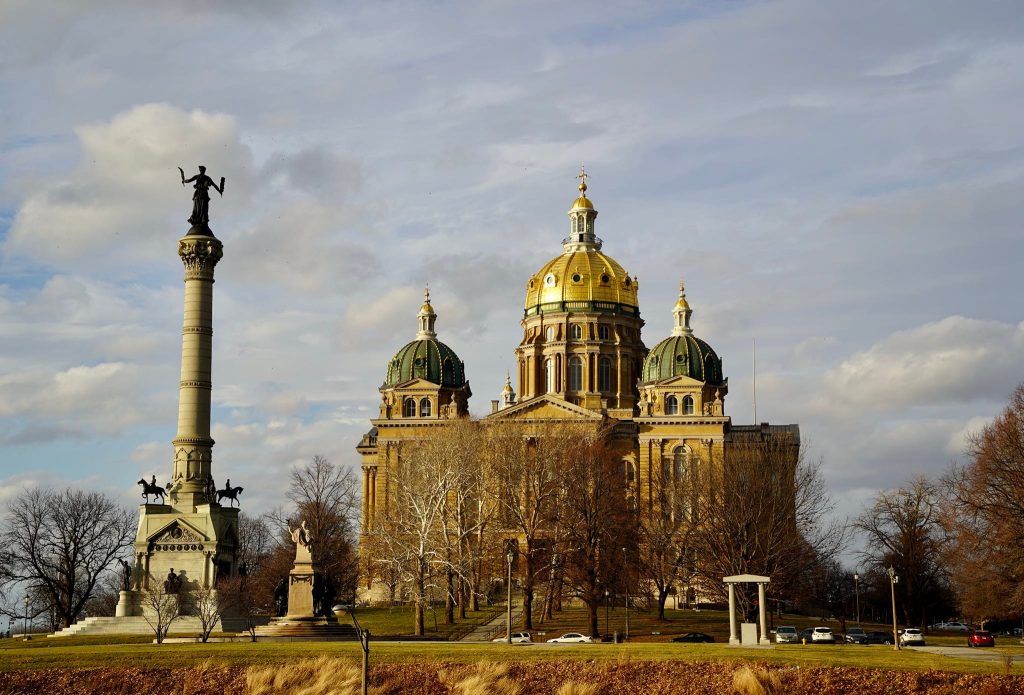
Iowa State Capital in December 2021— Iowa celebrated its 175th birthday on December 28th. Robin Fortney’s photograph captures our beautiful state capital.
“This is where state legislators have power to protect our natural resources or not. As citizens, we must make sure to vote for representatives that will advocate to protect our soil, air, woods, waters and wildlife for public health, recreation and long-term economic stability.” says IWL’s Iowa Conservation Director, Mike Delaney.
We are grateful that the Izaak Walton League provides UMRI a home within a respected organization and leaders that give credibility to our undertaking of addressing problems of Climate Change, compromised natural resources; polluted waters, destruction of habitats, flooding, sedimentation and food production. Most of the individuals and organizations who are committed and take action are volunteers who give hours of their time to the cause of improving our natural capital to create a harmonious life for all. We are Thankful for ALL of you!
Thinking Like a Watershed in 2022—
Starts with “Save Bloody Run” Goes to Court, January 4th @ 7 pm.
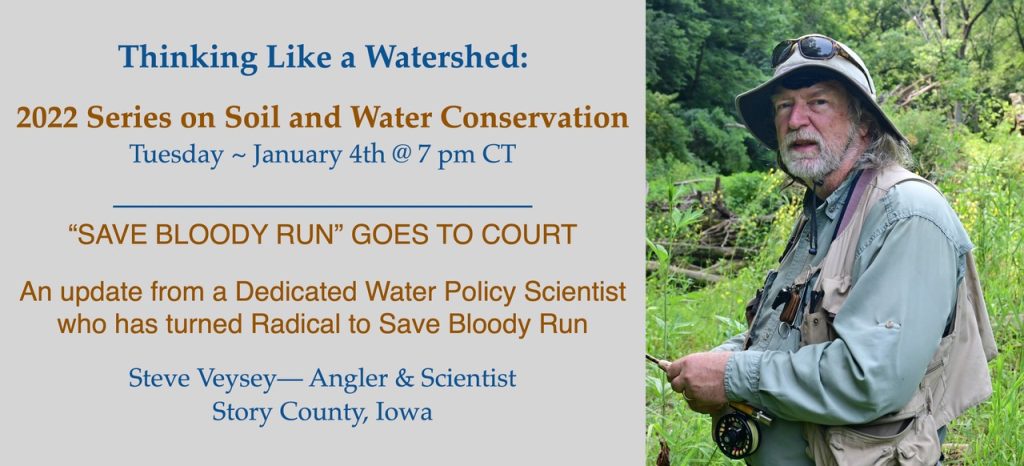
Photo by: David Thoreson
Join us Tuesday, January 4th @ 7 pm CT two days before “Save Bloody Run” goes to court to learn the latest updates from Steve Veysey about the efforts to protect Bloody Run Creek in Northeast Iowa. The creek is one of Iowa’s protected “Outstanding Waters” and yet is the site of a 11,600 head confinement beef operation progressing with questionable or even illegal state oversight. Steve, who has a long history challenging water quality policy and protocols, is one of the core “radicals” in a group known as the “Committee to Save Bloody Run.” You will also learn what you can do to help SAVE BLOODY RUN!
Steve will fill us in on the details of Supreme Beef’s facility and their blatantly flawed Nutrient Management Plan. The feedlot expansion is sited in Iowa’s delicate karst topography and evidence suggests that state officials, elected and otherwise, are facilitating an environmental pass that will result in the degradation of Bloody Run. If we can’t SAVE Bloody Run, a state – designated outstanding water, is there any hope for water quality in Iowa and beyond?
Besides being an avid angler, Steve has an extensive background in water quality policy issues. He retired from Iowa State University as the manager of the Chemical Instrumentation Facility and has spent the past 25 years working to improve water quality in Iowa. He is best known for efforts related to development and implementation of proper Clean Water Act standards for Iowa. He brings a strong science background and a willingness to understand “the devil in the details”of water quality standards and AFO regulations.
December Snapshots—
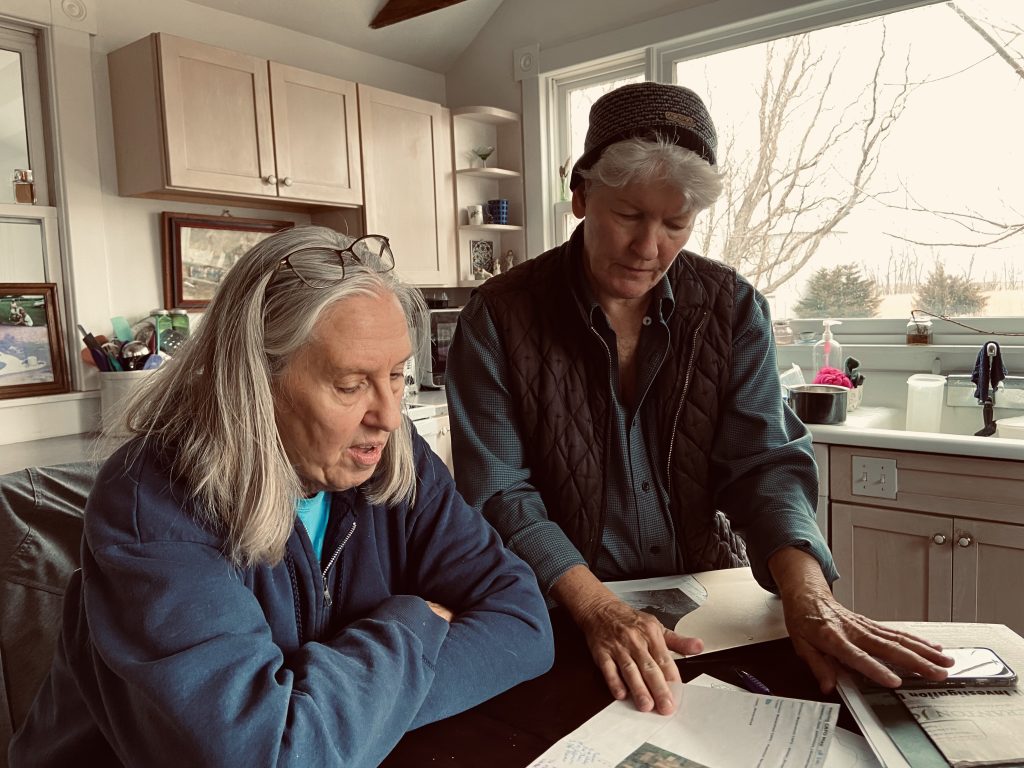
Susan Heathcote listens as Chris Henning shares her knowledge and maps about the tributary streams that flow into Squirrel Hollow before conducting the chemistry monitoring with the RRWA’s Greene Team. Photo by: Christine Curry
Throughout this year we have been working with our partners to amplify the voice of our watersheds, including Greene County’s Squirrel Hollow, where a recent hog confinement was erected. During the construction of the facility many of the tributary streams were dry because of this summer extreme drought. Because of the lack of water in the streams, the RRWA’s Greene Team was unable to collect any water samples from the streams until after the late November rains. During the first week of December there was enough water flowing in the streams, so a few members of the RRWA’s Greene Team met up in Jefferson to collect the SOS water chemistries of the tributaries that flow into Squirrel Hollow.

Curtis Cokeley collects water for the chemical monitoring in one of the nearby streams known as “Wally”. Photo by: Chris Henning
Data collected from the sites will continue to be added to the Izaak Walton Leagues’ National Hub. This data will help in monitoring water quality changes in the waterways due to confined animal operations that are being constructed in delicate areas of the Raccoon River watershed.
The SOS Save Our Streams Chemical Monitoring Data includes:
Dissolved Oxygen (DO)— is necessary for nearly all aquatic life to survive.
pH— is a measure of a water’s acid/base content and is measured in pH units on a scale of 0 to 14.
Chloride— Chloride is a chemical found in salts, which tend to dissolved easily in winter.
Phosphate— Phosphorus is an essential nutrient for plants and animals and is usually present in natural waters as dissolved orthophosphates.
Nitrate:N/Nitrite-N— Nitrogen is an essential plant nutrient, but excess nitrogen can cause water quality problems.
Transparency— Transparency is a measure of water clarity and is affected by the amount of material suspended in water.
Water temperature— Many of the chemical, physical, and biological characteristics of a stream are directly affected by water temperature.
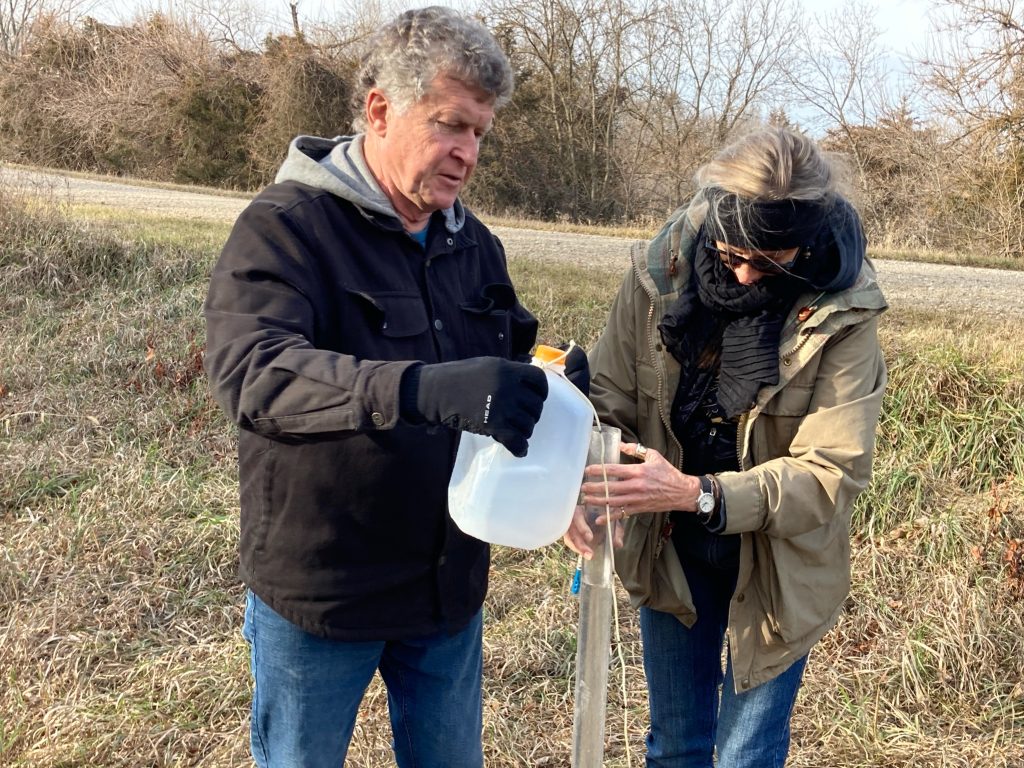
Curtis Cokeley and Christine Curry assess the transparency of the water in one of Squirrel Hollow’s tributary stream. Photo by: Chris Henning
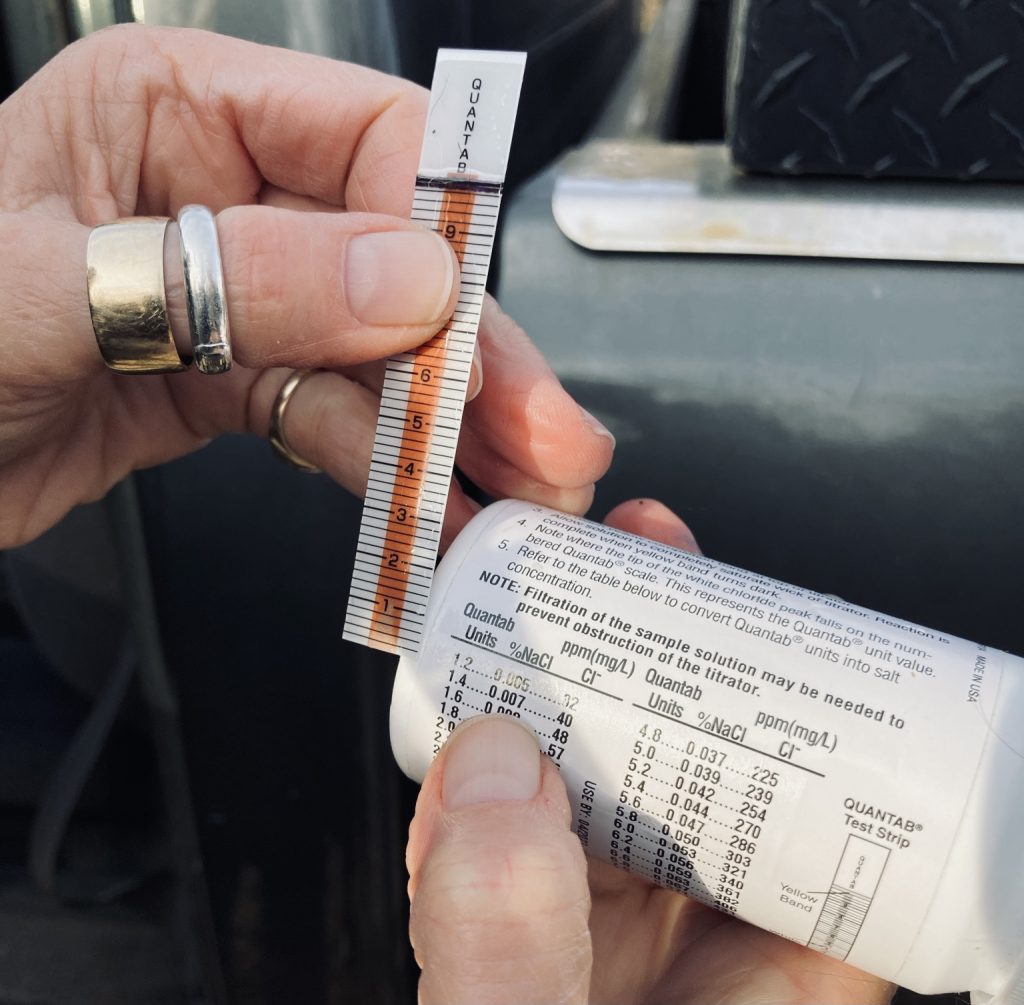
Chloride is one of the parameters collected with the SOS chemical water monitoring protocols. Photo by: Chris Henning
Natural Resources—
Our Muscatine community gathering took place during December 15th to discuss the Natural Resource needs for both public health and recreation. As with most of our community meetings, many advocated for improving water, air, clean energy, recreation and wildlife habitats. Climate and clean energy were also top on the list as we conducted this virtual Zoom meeting during what we now know was one of Iowa’s worst winter storms…a Derecho with 43 confirmed tornadoes. During this coming year, UMRI will be working with our IWL network and partners in the watershed to help find solutions to advocate and take action to improve water quality, soil health and food production for all life.
Talking about Natural Resources…Ding Darling: We need you now more than ever! There is a little more hope combining education and action with the new program at Drake University’s Jay N. Darling Institute which aims to educate students while improving our Natural Resources in rural communities throughout Iowa.
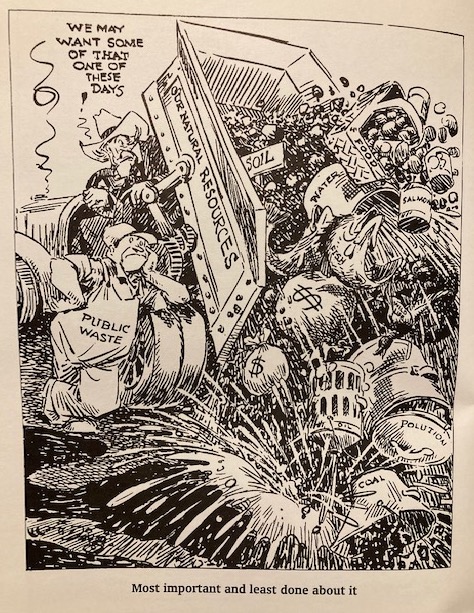
Image provided by Mike Delaney from J.N. “Ding” Darling’s Conservation and Wildlife Cartoons, J.N “Ding” Darling Foundation, 785 Crandon Boulevard, Suite 1206, Key Biscayne, Fl 331-2603 Tel (305) 361-9788.
2021 Reflections—
With our amazing partners, we moved forward with UMRI initiatives during another year of the COVID pandemic. We were able to capitalize through virtual Zoom meetings and gatherings. UMRI initiated, hosted, and or participated in many on-line and a few in person events. This included watershed meetings/discussions, projects, and conferences in collaboration with our partners within the IWL and our network. Minnesota and Iowa UMRI colleagues collaborated throughout the year to build content and connections with others throughout Upper Mississippi River Watershed.
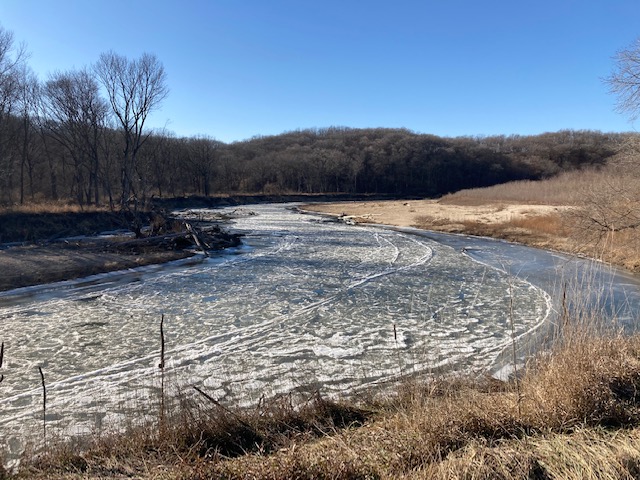
Raccoon River in December 2021. Photo by: Mike Delaney
2021 Accomplishments—
—Farmer’s Appreciation Night, DSM Chapter, where we feature farmers in our networks who are incorporating conservation practices to improve soil health, water quality and their production.
—Iowa Community Gatherings: Dallas County, Greene County, Linn County and Muscatine…where we discussed Natural Resource needs for both recreation and public health.
—UMRI’s Thinking Like a Watershed 2021 program…where we shared stories of watershed heroes and heroines
—SOS (Save Our Streams) https://www.iwla.org/water/stream-monitoring demonstrations and training in Squirrel Hollow, Bloody Run and Des Moines through the DSM Chapter
—Cedar River Water Monitoring e-coli training with MN Austin Chapter
On going support with SaveBloodyRun.org
—November Spark Iowa Banquet in collaboration with Drake University’s Soil Conference…where we showcased the Soul. Soil. Spark. vision and strategy for the future of Iowa.
—During this past year we have shared many great stories via our UMRI Monthly website features Iowa Conservation Efforts

Kuehn Conservation Area in Dallas County to enjoy woodland, prairie, big sky, moving water, and topography, December 2021. Photo by: Robin Fortney
Continuing in 2022—
— Build on establishing SOS teams throughout Iowa with additional SOS trainers and sites, public education and build awareness through citizen science outreach events.
—Collaborate with Minnesota UMRI and other IWL colleagues with “Thinking Like a Watershed” 2022 virtual Zoom program.
—Establish additional Non-operating landowner virtual series in partnership with UMRI Minnesota colleagues
—Build on improving Natural Resources with water quality and soil health initiatives and projects with partners in Greene County, Raccoon River, Linn County, Cedar River Muscatine and others Iowa communities.
—Feature the stories great works of farmers, conservationists and environmental advocates in our watershed networks and continue to help amplify their voices…creating a better world for all.
Learn more—
To help celebrate celebrate the Izaak Walton Leagues’ 100th anniversary in 2022, The Des Moines Chapter is heading up an effort to expand the Izaak Walton League’s SOS (Save our Streams) program throughout Iowa. This is the only nationwide program training volunteers to protect waterways from pollution and to bring information about water quality to their communities.
The IWL’s history: At the turn of the 20th century, uncontrolled discharges of industrial waste and raw sewage, unrestricted logging, and soil erosion threatened to destroy the nation’s most productive waterways. The country’s forests, wetlands, and wilderness areas were quickly disappearing. In 1922, 54 sportsmen declared that it was “time to call a halt” to this destruction. Aware that action – not just talk – would be necessary to solve these problems, the group decided to form an organization to combat water pollution and protect the country’s woods and wildlife. As a reminder of their purpose, they named the organization after Izaak Walton, the 17th-century English angler-conservationist who wrote the literary classic The Compleat Angler.
“Defenders of Soil, Air, Woods, Waters & Wildlife”
Continue to Stay Safe and Stay Engaged…
Save our Streams—On-line training to become a certified Izaak Walton League’s Save Our Stream monitor
Click Here to learn more about Save Bloody Run
Links to 2021 presentations are here:
—This is the video link: “Heartland Heroines” Thinking Like a Watershed ~ Robin Moore & Denise O’Brien— June 1, 2021
—This is the video link: “Planting Seeds to Grow Vibrant Communities” Thinking Like a Watershed ~ Chris Deal & Art Cullen— May 4, 2021
How Jefferson, Iowa’s Chris Deal is working with California Rep. Ro Khanna and others to grow vibrant rural communities in the Heartland with perspectives from Pulitzer Prize—winning journalist and editor of The Storm Lake Times, Art Cullen.
—This is the video link “Watershed Bridges— Green to Blue”: Thinking Like a Watershed ~ Vicki Nichols Goldstein & Seth Watkins— April 6, 2021 How improving soil health and water quality in Iowa and other inland states benefit watersheds that provide critical services from land to sea.
—This is the video link “Local Heroes in Howard County”: Thinking Like a Watershed ~ Neil Shaffer & Hunter Slifka— March 2, 2021 How they have incorporated several thousand acres of land under conservation programs–the largest percentage in Iowa.
—This is the video link “The Accidental Conservationist”: Thinking Like a Watershed ~ Wayne Fredericks— February 2, 2021 How an Iowa Farmer is Improving Natural Capital while Increasing Profits with Conservationist and Farmer, Wayne Fredericks from Mitchell County, Iowa.
— Izaak Walton League’s Outdoor America articles on line.
—About water quality monitoring and research, check out The University of Iowa’s Chris Jones blog who has published several articles on where Iowa stands with regards to soil health and water quality.
—Wait no longer to watch, re-watch and share PFI’s full-length film, “Livestock on the Land“. Please help us get this to as many viewers as possible – farmers, eaters, citizens and policymakers.
—Iowa Farmers Union Events, check out their amazing weekly webinars…
—Iowa Environmental Council’s Event page is packed with fabulous opportunities to learn more from their organization and others.
